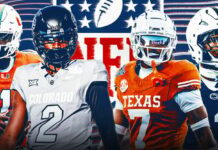Mr. Seth Waits, graduate of the class of 2001, language department head, president of the Jesuit Dallas Museum Trustees Board, and father of three, can now add “published author” to his repertoire with the release of his new book, With the Current, Against the Odds.
The thrilling book tells the story of a trio of recent college graduates tackling the 262 mile “World’s Toughest Canoe Race” from Central Texas to the Gulf of Mexico, having never paddled in the same canoe together. Without spoiling the contents of the book, The Roundup interviewed Waits on his recent publication.
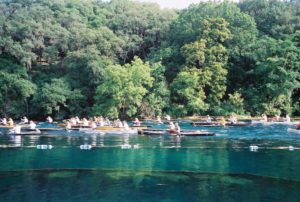
What inspired you to tackle the World’s Toughest Canoe Race?
I talk about [what inspired me to tackle the World’s Toughest Canoe Race] in chapter one of the book. I learned about it when I was a junior or a senior in high school here at Jesuit. There was an article in the Dallas Morning News that profiles the race; it occurs every June, so it was around that time after my junior year when they were profiling a local team that was going to compete in the race. I saw the article, read it, and didn’t know anything about the race prior to that but thought it looked interesting, so it just always stuck in my mind as something that I’d maybe like to do at some point.
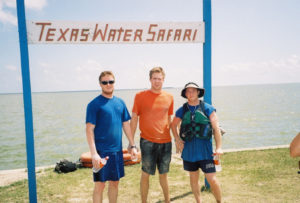 Chapter 2 of the book talks about my decision with whom I would compete, how I determined who I wanted my teammates to be in, and how I went about asking them to do the race. It took me a couple of attempts to find somebody that was also interested in doing the race, but I did find two people. One was a fellow Jesuit student. He’s two years older than me, but we were in the same Boy Scout Troop and had canoed and hiked and camped a lot before. Then another was a college friend at St. Louis University that I got to know there, so even though I learned about the race when I was 17 or 18, I did not end up competing in the race until nearly the end of college.
Chapter 2 of the book talks about my decision with whom I would compete, how I determined who I wanted my teammates to be in, and how I went about asking them to do the race. It took me a couple of attempts to find somebody that was also interested in doing the race, but I did find two people. One was a fellow Jesuit student. He’s two years older than me, but we were in the same Boy Scout Troop and had canoed and hiked and camped a lot before. Then another was a college friend at St. Louis University that I got to know there, so even though I learned about the race when I was 17 or 18, I did not end up competing in the race until nearly the end of college.
What was your experience and/or training leading up to the canoe race?
My experience with training leading up to the canoe race was minimal. The internet was not what it is now, and I kind of talked about that in the book; there weren’t a lot of message boards or pictures available of the course itself. There was not a lot of literature out there either. The Texas Water Safari organization had a website, but it was pretty rudimentary. So other than simply signing up for it and knowing where it started and where it finished, we didn’t really know too much about it.
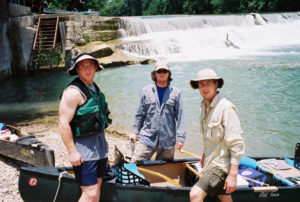
None of the three of us knew anybody that had competed in the race before, so a lot of it was just us coming up with the gear, finding a canoe that we could use as our vessel, and coming up with stuff that we thought would be would be best for training. Some of us just did some calisthenics, push-ups, pull-ups, and things like that to try to build our back muscles, but there was really no distinct regimented training ritual or anything like that leading up to the race. The three of us also were in three different states during all of our planning: John, my friend from SLU, was working for an airline company up in New York, Ben, the guy from Jesuit class of 99 was in Georgia working on his master’s, and I was in St. Louis at Saint Louis University. In the book, I talk about the first time that we had all three been in the same canoe was about five minutes before the race began.
Without spoiling the book, what was the largest obstacle you and your boat mates faced along the journey?
 This kind of picks up with my answer for question number two:, the three of us had never been in the same canoe until the day of the race. We were participating in what was meant to be a two-man canoe, but we had three people in it. Being cramped inside of a canoe and never having practiced how we would make our strokes and how we would coordinate and communicate within the boat was by far the biggest obstacle. But another pretty big obstacle was that John and Ben did not know each other at all. They only met each other face-to-face a day or two before the race when we all came to Dallas and eventually drove down to Central Texas to start the race. So I didn’t realize it at the time and I talked about this in the book, but I was a little naive and just assuming that because I trusted each of them so much and I knew how qualified each of them was and their skills and their knowledge and ability to stay calm under pressure, I just assumed that each of them would see these same qualities in each other pretty quickly. That obviously isn’t the case when you’ve never met somebody. That immediate trust is not automatically there, especially when you’re thrust into a difficult situation in a race like this.
This kind of picks up with my answer for question number two:, the three of us had never been in the same canoe until the day of the race. We were participating in what was meant to be a two-man canoe, but we had three people in it. Being cramped inside of a canoe and never having practiced how we would make our strokes and how we would coordinate and communicate within the boat was by far the biggest obstacle. But another pretty big obstacle was that John and Ben did not know each other at all. They only met each other face-to-face a day or two before the race when we all came to Dallas and eventually drove down to Central Texas to start the race. So I didn’t realize it at the time and I talked about this in the book, but I was a little naive and just assuming that because I trusted each of them so much and I knew how qualified each of them was and their skills and their knowledge and ability to stay calm under pressure, I just assumed that each of them would see these same qualities in each other pretty quickly. That obviously isn’t the case when you’ve never met somebody. That immediate trust is not automatically there, especially when you’re thrust into a difficult situation in a race like this.
What motivated you to write With the Current, Against the Odds?
Without giving too much away from what happened in the book, I knew right after it happened that [the race] was something that was important to me, that I learned a lot from, and that I got a lot out of. I knew I would probably want to try to write some of it down just to have those memories on paper both for myself and to share with anybody else later in my life, but I didn’t really write anything down as soon as it happened. In the back of my mind, I knew I might want to do something with it, and looking back now, I wish I would have written down some more details right after it happened so that I would have had those for the book.
I started getting into writing a little bit more by dabbling with some short stories and different events that I wanted to write down from my childhood memories and things like that. But I hadn’t really started doing any writing at the time of the race. I just knew that it was an interesting enough event and experience that I would probably want to do something with it at some point, but I didn’t have any details beyond that initial desire to maybe write about it at some point.

Writing a 200-page book is a daunting task by itself, and you managed to do it while chairing the language department at Jesuit and raising a family among all else. How did you manage writing With the Current, Against the Odds with such a packed schedule?
Well, it took me almost six years to write the book from start to finish. It was the summer coming up on six years ago when I was on a plane ride and decided that I wanted to start thinking through how I would write down my memories from the event. So I blocked out the chapters and really set in motion what would that look like. How would I envision telling that story? And what would that look like?
I just started working on it in whatever spare time I had: summers when I wasn’t teaching, sometimes in the evening during the school year if I had my work done, and even occasionally at school either during a free period or staying after school if I had my work done. I’ve joked to some friends that if I were to write another book, it would be titled “How to Write a Book in 30 Minute Increments” because the majority of the time, I would write for 30 to 45 minutes, which is really just enough time to get your documents out and remember where you stopped last time, to write for about five or ten minutes, then to save your work and shut down. It definitely was not the ideal writing procedure, but that’s just how it worked for me. I would have a two week period where I would be intentionally focused on the book, and I’d work on it almost every day then put it on the back burner for about two weeks. For whatever reason, that’s how I operated during the school year: two weeks on two weeks off.
When we had our kids, either our first or second son, I didn’t touch it and only came back to it a year later. So, all in all, it took me a little under 400 hours from start to finish, including researching and interviewing my teammates, putting it together, editing and that sort of stuff. It would have taken a lot less than six years if I didn’t have a full-time job and didn’t have three kids during that time, but it just was important enough to me that I put priority on working on my book over evenings in front of Netflix or video games or anything like that. It was something that I knew if I kept at it, I’d have a tangible end product that I’d be proud of, whereas with other leisure activities, sometimes where there’s no end product.
What advice would you give an aspiring author navigating the book-writing process?
If you’ve never done it before, it’s a long and arduous journey. To be honest, it was fun but really, really challenging for me. I don’t think it’s this way for everybody, but for me, it was a very individual process. I really didn’t talk to anybody about what I had done or work with anybody along the way; it was just me and my thoughts and my word document for about four or five years. Nobody looked at anything that I had written until the editing process began, so it was a solo journey. There was definitely a high learning curve, too, so if I were to write a book now, it would take me a lot less time.
There’s a lot to learn that very first time in writing, editing, and formatting it to become a book. In spite of the challenges, having the end product is incredibly rewarding. It feels great to be done after all these years. Occasionally not thinking I would ever be at a point where it would be ready, it feels really good to have a finished product: for me, for my sons, for my friends, for people that I’ve talked to, for people that I’ve known for a long time that remember me doing the race back in 2005.
Where to Buy
With the Current, Against the Odds is currently available on Amazon for $13.99, and you can purchase a copy directly from Mr. Waits for the same price.
Charitable Cause
To top off an already amazing story, Mr. Waits is donating one dollar from every book sold to a charitable cause close to his family:
“In 1992, the Batwa pygmies, indigenous forest nomads of Uganda’s Bwindi Impenetrable Forest, were removed from the forest when the forest was made a World Heritage Site to help protect the endangered mountain gorillas living there. The exiled Batwa who had thrived as hunter-gatherers for millennia in the rainforest were left in extreme poverty, homeless and destitute, with no land of their own, limited job skills, and few options for improving their lives.

In 2000, a Dallas doctor named Scott Kellerman visited the Batwa people on a medical mission. So impacted by what he witnessed, he and his wife moved to Uganda the following year to work with them full-time. They established the Scott Kellerman Foundation in 2004 to focus on three priorities: healthcare, nursing education, and community development.
My parents visited the Batwa community for the first time in 2008. Following their visit, they donated funds from my late grandmother’s estate to build a school in her name. The Nina Waits Mukongoro School, built in 2011, honors my grandmother’s forty years as an elementary school teacher. It was built on the site of a previous school structure, a mud-walled and thatched roof edifice with dirt floors. My parents have since visited the Batwa three more times and continue to support them through the SKF.
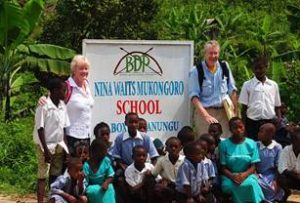
One hundred percent of the money raised from this novel will be used for educational initiatives within the Batwa community.”
Celebratory Event
An event celebrating With the Current, Against the Odds’ release took place last night, Tuesday, April 23 from 5:30 to 7:00 pm at Jesuit and included:
- books available for purchase
- a presentation of and remarks by the book’s main characters
- book signing by the author
- a dramatic reading of several passages from the book
- a short video detailing the Texas Water Safari
The Roundup congratulates Mr. Seth Waits on his impressive work. Stay tuned to The Roundup for more exciting Jesuit Dallas news.



